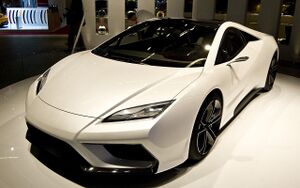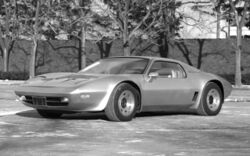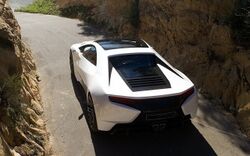Pantheon Dalliante
| Pantheon Dalliante | |
|---|---|
 2015 Pantheon Dalliante GT at the Rodzanican International Auto Show | |
| Overview | |
| Manufacturer | Pantheon Motor Company |
| Also called | Pantheon 3552 Pantheon Model 37 |
| Production | July 1969-Present |
| Assembly | Izalgrod, Rodzanica |
| Body and chassis | |
| Class | Sports car S-segment |
| Body style | |
| Layout | mid engine, rear wheel drive |
| Powertrain | |
| Engine |
|
| Transmission |
|
| Dimensions | |
| Wheelbase |
|
| Length |
|
| Width |
|
| Height |
|
| Curb weight |
|
| Chronology | |
| Predecessor | Pantheon Model 35 |
The Pantheon Dalliante (Rodzanican: Пантеон Мерцание) is two-door, mid-engined, rear-wheel drive sports car manufactured by Pantheon Motor Company in Izalgrod, Rodzanica. Initially introduced in 1969, the Dalliante is one of the nation's longest continually manufactured marques; remaining conceptually unchanged for five decades since it's debut. It was initially developed as a spiritual successor to the older Model 35, utilizing the same air-cooled layout of it's predecessor - though packaged in a smaller and more affordable platform.
History
Mark I Concept
The original Dalliante design was conceived in early 1960s as part of a series of concept sketches made for the 1962 Izalgrod Automotive Exhibition. These drafts envisioned the car as an lightweight, two-seater, mid-engined roadster, a radical departure from Pantheon's core portfolio of luxury cars and limousines.
The upper echelons of Pantheon management hoped to use the concept as a showcase vehicle to demonstrate the brand's shift into the lucrative racing market, which had seen a boom in popularity at the end of the previous decade. Initial design was finalized in just two months, and a rolling chassis - christened the Mark I - was showcased at the Expedition at July 20th.
Public reception to the sporty Pantheon was positive, attracting attention as a show car over the course of the next couple of months. The company adapted a 1,600cc air-cooled V4 engine, supplied by Voromash, to fit the Mark I's low-slung dimensions, completing full design work in 1963. The Mark I would be exhibited across the nation for the next year, generating hype and drawing the company into the public eye as a potential contender against the ubiquitous foreign sports coupés of the era.
Despite it's appeal, however, much of company management was hesitant to put the Mark I to the assembly lines. Many worried as to whether the new design could potentially dilute the Pantheon brand name, and cannibalize the automaker's existing luxury vehicle sales. There were also concerns as to the feasibility of engineering and manufacturing a production-worthy design, particularly in the midst of the oversaturated premium car market. The Mark I would end up relegated as a one-off publicity piece, with the singular prototype stored away in 1964.
First-Generation
Interest in the concept of a high-performance Pantheon sports car would come renewed in 1966, with the naming of Viktor Sagarin as the new executive officer. Hoping to expand the company into the mid-tier price bracket, Sagarin looked for a flagship design to crown a new lineup of affordable offerings for the next decade. An experienced racing driver himself, Sagarin was particularly drawn to possibilities offered by the shelved Mark I - ordering the project to be reopened immediately. He detailed three principles for a new 'Mark II': It would have to seat four, have performance and appeal equal or superior to that of the company's existing offerings, and cost less than $4,000.
Initial prototypes of the refreshed coupé were unveiled internally in 1968. The new car, named the Dalliante, was based loosely on the underpinnings of the original Mark I, but shared components with the majority of Pantheon's existing lineup. It's frame, suspension, and interior were developed in tandem with the RAZ company, reducing costs and cutting development time. By the Spring of 1969, production models had already begun to hit showroom floors.
Early first-generation Dalliantes were offered with only a single choice of powerplant and transmission: the venerable Pantheon 2.4L inline-six cylinder and 4-speed manual, producing 115 horsepower and 120 lb/ft of torque. These models, commonly known as the 'A-series', were offered at a starting MSRP of $3,799. Initial sales were slower than anticipated - and with an inventory of over 11,000 unsold cars, the design was quickly reexamined for the upcoming decade.
1970 would bring a host of changes to the Dalliante design. The 'B-series' was introduced with a number of functional changes, modernizing the overall silhouette and offering a host of new powertrain options. The 2.4L powerplant was fitted with new triple-barrel carburetors and uprated to 130 horsepower, while two new 2.8L and 3.2L I6 engines became available (producing 140 and 165 horsepower, respectively). Pricing was also reduced to just $2,999 for the base GT model - and the cheaper, more muscular car begin to catch on, rapidly growing to over 120,000 units sold per year. By 1972, selections such as power windows, air conditioning, hydraulic disk brakes, and electric folding hardtop had all been introduced to meet the unexpected new demand.
Sixth-Generation
Chassis
The Sixth-Generation Dalliante (internal designation Model 3552) was introduced in 2012 as an entirely new platform, featuring a lengthened chassis and wheelbase. Simultaneously, front and rear overhangs were trimmed and the rear track was widened by 60mm over the outgoing design, markedly increasing passenger volume. The sixth-generation was the first to adopt multilink suspension - which, paired with the company's proprietary Magnetrack dampers, claimed to afford an over 23% increase in lateral-G tolerance. The coupe is fitted as standard with four-wheel six-caliber ventilated disk brakes, though an optional upgrade to a tri-rotor carbon-ceramic package was offered on the GTS and GTR models. Steering is provided through a electromechanical rack-and-pinion system.
The new cars featured complete aluminium construction, built on a unitary body and assembled with self-piercing rivets. As a result, despite being larger and more powerful than previous model years, base sixth-generation Dalliantes had a 250 lb reduction in curb weight over their predecessors. To improve cornering traction, GTS and GTR variants were offered with Pantheon's intelligent electrohydraulic four-wheel steering; which, when combined with an overall increase in wheel footprint, provides particularly precise and agile cornering characteristics.
During it's development, handling was considered a particular priority for the upcoming model; and as such a number of proprietary technologies were unveiled alongside the new design. These included an intelligent torque-vectoring system which used both the car's limited-slip differential and electronically-controlled braking to create a more aggressive handling profile. The chassis was fitted with fully active aerodynamic cladding - a first for the company - as well as a computerized rear spoiler, which could deploy at speeds over 75 mph to improve braking and increase downforce.
In the 2017 model year, Pantheon introduced a revised model of the Dalliante specifically meant for foreign export. The GTS and GTR models were both offered overseas starting in August of 2016, produced in both right and left-hand drive versions. Foreign variants were fitted with improved safety equipment, including lane assist and smart braking features, and priced at approximately $12,500 higher at MSRP over their domestic counterparts.
Engine
The Dalliante is offered in three trim levels: the GT, GTS, and GTR. Both the GT and GTS trims are offered with Pantheon's 24-valve DOHC 3.6 liter turbocharged six-cylinder engine, producing a peak of 375 horsepower (380 PS; 280 kW) and 310 lb/ft of torque (420 Nm). The GTR features a twin-turbo 4.0 liter powerplant, increasing output to 450 horsepower (455 PS; 335 kW) 380 lb/ft of torque (515 Nm). With the exception of the 4.2 liter engine in the limited-production 1972 Dalliante GTR, the four liter model is the largest powerplant fitted to any Dalliante to date.
The 3.6 liter variant is manufactured from high-silicon cast-aluminium, with an all-aluminium block and plasma-coated hypereuretic pistons. Fuel is fed through a dual direct and port injection system, running at a 12.5:1 compression ratio on 91 octane gasoline. In 2018, both the 3.6 and 4.0 models were revised with new exhaust manifolds, larger valves and revised ECU programming, marginally improving emissions and fuel economy. The engines are mated to a 7-speed dual-clutch automatic as standard, though a performance 7-speed manual is also offered for GTS and GTR models.
| Model | Year | Engine cc | Power | Torque | Compression Ratio |
|---|---|---|---|---|---|
| Dalliante GT | 2012-Present | 3,625 cc (221 cu in) I-6 | 375 bhp (280 kW; 380 PS) @ 6,500 rpm | 310 lb⋅ft (420 N⋅m) @ 6,500 rpm | 12.5:1 |
| Dalliante GTS | 2012-2018 | 3,625 cc (221 cu in) I-6 | 375 bhp (280 kW; 380 PS) @ 6,500 rpm | 310 lb⋅ft (420 N⋅m) @ 6,500 rpm | 12.5:1 |
| 2018-Present | 3,625 cc (221 cu in) I-6 | 385 bhp (287 kW; 390 PS) @ 6,500 rpm | 325 lb⋅ft (441 N⋅m) @ 6,500 rpm | 12.5:1 | |
| Dalliante GTS Supersport | 2012-2018 | 4,005 cc (244 cu in) I-6 | 450 bhp (336 kW; 456 PS) @ 6,700 rpm | 380 lb⋅ft (515 N⋅m) @ 5,900 rpm | 10.9:1 |
| 2018-Present | 4,005 cc (244 cu in) I-6 | 455 bhp (339 kW; 461 PS) @ 6,700 rpm | 390 lb⋅ft (529 N⋅m) @ 6,000 rpm | 11.0:1 | |
| Dalliante GTR | 2017-Present | 4,005 cc (244 cu in) I-6 | 455 bhp (339 kW; 461 PS) @ 6,700 rpm | 390 lb⋅ft (529 N⋅m) @ 6,000 rpm | 11.0:1 |
| Dalliante GTR Supersport | 2017-Present | 4,005 cc (244 cu in) I-6 | 520 bhp (388 kW; 527 PS) @ 7,000 rpm | 450 lb⋅ft (610 N⋅m) @ 6,200 rpm | 13.0:1 |
Performance
Seventh Generation
| Seventh Generation (3554) | |
|---|---|
| Overview | |
| Production | 2019-Present |
| Assembly | Izalgrod, Rodzanica |
| Body and chassis | |
| Class | Sports car S-segment |
| Body style | 2-door coupé |
| Layout | mid engine, all wheel drive |
| Powertrain | |
| Engine | 3.8 L twin-turbocharged Inline-6 |
| Electric motor | Dual front electric motors, single rear electric motor |
| Transmission | 8-speed dual clutch |
| Dimensions | |
| Wheelbase | 2,520 mm (99 in) |
| Length | 4,290 mm (169 in) |
| Width | 1,950 mm (77 in) |
| Height | 1,220 mm (48 in) |
| Curb weight | 1,680 kg (3,704 lb) |



